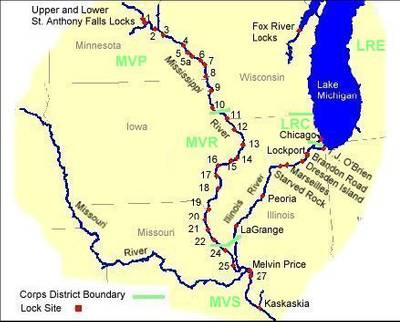MarAd Assesses Economic Impact of Lock Closures
Due to rising flood waters, the U.S. Army Corps of Engineers is closing nine locks and dams on the upper . Lock 16 in , was the first to close on Thursday, June 12. The last to close will be Lock 25 in . The closures will temporarily halt barge traffic on more than 200 miles of the UMR. The Corps of Engineers notified industry of the closures on Sunday June, 8 and update industry and other stakeholders daily. Industry representatives have reported that they have had plenty of warning to get their boats moved out of the closed portion of the river to avoid being trapped.
The Upper Mississippi River (UMR) is an integral part of a national inland water transportation network which provides an important transportation link both into and out of ’s . The UMR navigation system runs for 1,200 miles or 10 percent of the Inland Waterway System, and serves a five-state region. Reliable navigation conditions are created in the system by a series of 29 lock and dam facilities. , , and Minneapolis-St. Paul are the major metropolitan areas served directly by the system and many smaller communities depend on the river as well. The UMR has traditionally served as the primary route for international trade of grains produced such as wheat, corn and soybean in the five-state region. Over 50 percent of tonnage moved on the system consists of non-grain products, such as fertilizers, chemicals, equipment and coal.The demand for lock use annually by operators (carriers) builds from a very low level in the winter months to a peak level of use in July and August and then gradually declines through the fall months back to a very low level of use by the end of each calendar year.
Since the system is stable in terms of traffic volumes and commodity type, in order to evaluate any potential impact for the proposed closure, the Maritime Administration analyzed last year's traffic that passed through these locks from June 12, 2007 until June 26, 2007. According to Corps of Engineers' estimates, some of these locks service millions of tons of cargo a year. For example, in 2007, volume at Lock and Dam 19 totaled 26.3 million tons. Major commodities carried included grain, aggregates, petroleum, coal, and chemicals. Growth in traffic in this stretch of the river is expected to reach 31.5 million tons in 2010. More than 1,900 commercial towboats and 16,773 loaded barges transited Lock 19 in 2007.Below is the total tonnage and vessels passing through each lock marked for closure on the system.
The nine locks slated for closure lie north of where the Illinois River meets the .
Some local barge operators say that means they shouldn't be hurt by the closure. Barges generally carry grain from the upper Midwest down-river to , where they are unloaded for export. Those barges would then be filled with cargo like coal, steel, concrete, etcetera and sent up to and . A lengthy closure could add millions of dollars to the costs of transporting grain and other commodities carried on the system and reduce the real incomes of farmers, other producers and consumers. However, this closure is expected to last only two weeks during a slow shipping season, therefore, no significant economic impact is foreseen for the region.
For more information on the economic impact of lock closures, visit MarAd’s site.

















